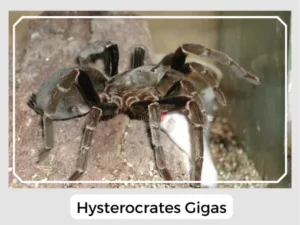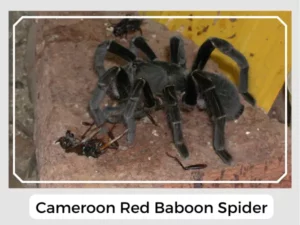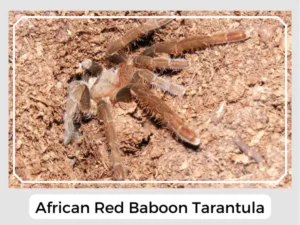The African red baboon tarantula is a fascinating spider from Cameroon. Many people like to have them as pets, but they also love living in the wild, especially in rainforests. These spiders like it warm, enjoying places that are between 70° to 90°F.

Photo Credit: titin soriano
The other prominent physical features include hairy legs and parallelly arranged fangs, facing downwards. Though sexual dimorphism exists, it is not prominent till they reach 4 years of age, as males survive only till that time though females live longer.
The silken sac contains about 100 eggs, which the female guards with utmost care.
They live together for around six months before dispersing, some of them stay longer. They do not display the typical behavior of preying upon one another for food. Instead, They have been seen sharing food with their kin.
The African red baboon tarantula spiderlings go through about eight molts during the first year. However, it isn’t easy to spot them. Hence, not much is known about their color and appearance.
They do not spin webs but make burrows lined in silk. In fact, as per arachnologist Sam Marshall these spiders dig intricate burrows.
Yes, African Red Baboon tarantulas have venom. But for most people, it isn’t very harmful. They use it to catch and eat their meals.
Yes, they can bite. If they feel threatened or scared, they might give a bite. It could be a bit uncomfortable and may lead to symptoms like pain, redness, swelling, or even nausea, but it’s not usually very bad.

Photo Credit: titin soriano
The African Red Baboon Tarantula plays a pivotal role in controlling insect populations within its habitat, contributing to the ecological balance of the rainforest ecosystem. Their burrowing behavior aids in soil aeration, while their predatory nature helps regulate insect populations.
Natural Predators: While they sit atop their food chain, these tarantulas are not without threats. Wasp ants, birds, scorpions, other tarantulas, and beetles pose as natural predators, creating a dynamic and interconnected web of life in their rainforest home.
Prey-Predator Dynamics: As apex invertebrate predators, the African Red Baboon Tarantulas exert top-down control on the population of smaller insects and vertebrates, ensuring a balanced ecosystem and preventing any single species from becoming overly dominant.
Relationship with Humans: In recent years, these tarantulas have gained popularity in the exotic pet trade. However, it is crucial for potential keepers to understand their specific care requirements and acknowledge their defensive nature. Their presence in the wild, apart from adding to the biodiversity, plays an instrumental role in pest control, indirectly benefiting agricultural practices in regions adjacent to their habitats.

Photo Credit: shadowshador
| Other Names | Cameroon red baboon spider, giant baboon spider, and red baboon spider |
| Distribution | Cameroon |
| Habitat | Burrows in sub-tropical and tropical environments |
| Diet | Moths, butterflies, cockroaches, crickets, snakes, frogs |
| Predators | Wasp ants, birds, scorpions, tarantulas, and beetles |
| Lifespan | Male: 4 years Female: Upto 10 years |
| ICUN Conservation Status | Not listed |
In summary, the African Red Baboon Tarantula stands as a testament to the intricate beauty and complexity of the arachnid world.
The African red baboon tarantula is a fascinating spider from Cameroon. Many people like to have them as pets, but they also love living in the wild, especially in rainforests. These spiders like it warm, enjoying places that are between 70° to 90°F.

Photo Credit: titin soriano
The other prominent physical features include hairy legs and parallelly arranged fangs, facing downwards. Though sexual dimorphism exists, it is not prominent till they reach 4 years of age, as males survive only till that time though females live longer.
The silken sac contains about 100 eggs, which the female guards with utmost care.
They live together for around six months before dispersing, some of them stay longer. They do not display the typical behavior of preying upon one another for food. Instead, They have been seen sharing food with their kin.
The African red baboon tarantula spiderlings go through about eight molts during the first year. However, it isn’t easy to spot them. Hence, not much is known about their color and appearance.
They do not spin webs but make burrows lined in silk. In fact, as per arachnologist Sam Marshall these spiders dig intricate burrows.
Yes, African Red Baboon tarantulas have venom. But for most people, it isn’t very harmful. They use it to catch and eat their meals.
Yes, they can bite. If they feel threatened or scared, they might give a bite. It could be a bit uncomfortable and may lead to symptoms like pain, redness, swelling, or even nausea, but it’s not usually very bad.

Photo Credit: titin soriano
The African Red Baboon Tarantula plays a pivotal role in controlling insect populations within its habitat, contributing to the ecological balance of the rainforest ecosystem. Their burrowing behavior aids in soil aeration, while their predatory nature helps regulate insect populations.
Natural Predators: While they sit atop their food chain, these tarantulas are not without threats. Wasp ants, birds, scorpions, other tarantulas, and beetles pose as natural predators, creating a dynamic and interconnected web of life in their rainforest home.
Prey-Predator Dynamics: As apex invertebrate predators, the African Red Baboon Tarantulas exert top-down control on the population of smaller insects and vertebrates, ensuring a balanced ecosystem and preventing any single species from becoming overly dominant.
Relationship with Humans: In recent years, these tarantulas have gained popularity in the exotic pet trade. However, it is crucial for potential keepers to understand their specific care requirements and acknowledge their defensive nature. Their presence in the wild, apart from adding to the biodiversity, plays an instrumental role in pest control, indirectly benefiting agricultural practices in regions adjacent to their habitats.

Photo Credit: shadowshador
| Other Names | Cameroon red baboon spider, giant baboon spider, and red baboon spider |
| Distribution | Cameroon |
| Habitat | Burrows in sub-tropical and tropical environments |
| Diet | Moths, butterflies, cockroaches, crickets, snakes, frogs |
| Predators | Wasp ants, birds, scorpions, tarantulas, and beetles |
| Lifespan | Male: 4 years Female: Upto 10 years |
| ICUN Conservation Status | Not listed |
In summary, the African Red Baboon Tarantula stands as a testament to the intricate beauty and complexity of the arachnid world.